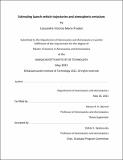Estimating launch vehicle trajectories and atmospheric emissions
Author(s)
Pradon, Cassandre Victoria Marie
DownloadThesis PDF (3.879Mb)
Advisor
Barrett, Steven R. H.
Terms of use
Metadata
Show full item recordAbstract
Launch vehicles enable Earth observation, navigation or space exploration. In doing so, they cause direct anthropogenic emissions in the troposphere and above. This comes with an environmental cost. They can emit carbon dioxide (CO2), water vapor, chlorine, aluminum oxide, black carbon and nitrogen oxides that lead to atmospheric changes such as ozone depletion. Historically, because launches were part of national security concerns, rockets have not been subjected to environmental regulation. The few studies in the 1990s due to the decreasing number of launches have helped rockets avoid any policy regulation. However, the development of commercial launches and the evolution of engine designs has created a need to reassess the impact of rocket launches. My work presents an inventory of stoichiometric emissions of rocket launches between the years 2009 and 2018. I first compile all publicly available data of launches between 2009 and 2018, then I design a program to simulate the trajectory of any launch vehicle under an altitude of 100 km. This model gives a profile of fuel burn and stoichiometric emissions as a function of altitude for many launch vehicles. The exhaust products of interest are CO2, water vapor, chlorine and aluminum oxide. Between 2009 and 2018, 140.5 kt of CO2 were emitted in the atmosphere, 78.9 kt of water vapor, 5 kt of chlorine and 7.8 kt of alumina were emitted above the tropopause. The increase in the number of launches has made CO2 emissions grow by 73% between 2009 and 2018, while water and chlorine emissions have decreased by 25 and 58% since 2009 because of the retirement of the Space Shuttle. The rise in kerosene-fueled rockets launches is making CO2 emissions increase faster than the number of launches and suggests that water vapor emissions are going to increase again. Launch vehicles are compared and reveal that trade-offs are necessary to minimize the different emissions.
Date issued
2021-06Department
Massachusetts Institute of Technology. Department of Aeronautics and AstronauticsPublisher
Massachusetts Institute of Technology